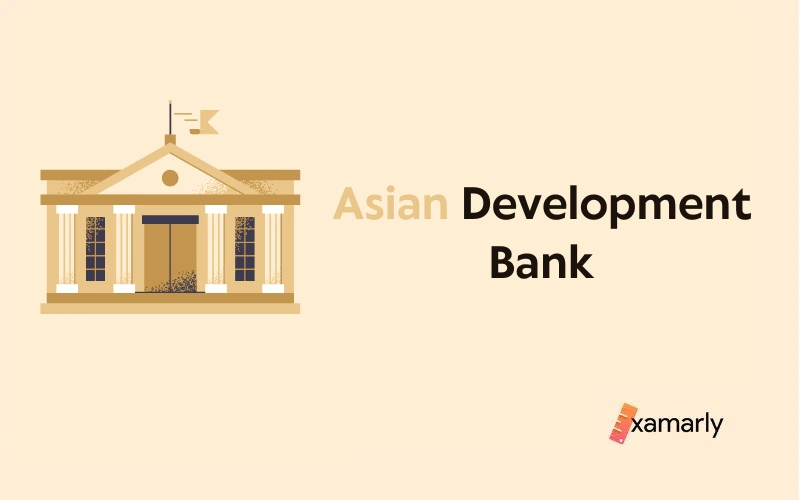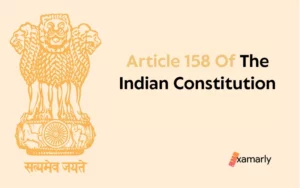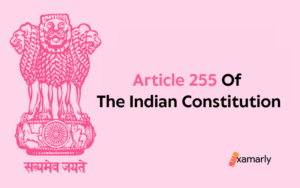The role of the Asian Development Bank (ADB) in shaping the financial landscape of India and other nations cannot be overstated. As a prominent international organization, it frequently garners attention in the news, making it an important topic for those preparing for the UPSC exam.
Ashok Lavasa has been selected by the ADB as their Vice-President for Public-Private Partnerships and Private Sector Operations. This development holds significant relevance for the IAS Exam, and keeping up with such updates is crucial for aspirants.
- All About Asian Development Bank for UPSC CSE
- Origin
- Past Presidents
- Know About ADB for UPSC
- Objectives and Aims of ADB
- Why was the Asian Development Bank Necessary?
- Do You Know?
- Focus Areas
- ADB Members
- Asian Development Bank and India
- What is ADB's 2030 Strategy?
- Governance
- Criticism
- Significance of ADB
- Conclusion
- FAQs On ADB
All About Asian Development Bank for UPSC CSE
The Asian Development Bank is a regional organization that provides equity investments to member countries in a number of fields including healthcare, public administration, and finance. Its primary mission is to reduce poverty in Asia and foster regional integration and environmental sustainability.
The organization provides different forms of loans: both hard loans and soft loans to member countries. You can apply to join this institution by filling out an online application.
- The Asian Development Bank (ADB) was formed in 1966 to meet the needs of Asia’s developing countries.
- With 31 field offices in various parts of the world, the bank works to bring about socio-economic development across the region.
- ADB is owned mainly by Japan (15.677%), the U.S.A (15.567%), China (6.473%), and India (5.812%) with the highest percentage being held by Japan.
- Its funding assistance in India is focused on assisting low-income countries, increasing economic development, and creating new jobs.
- The Asian Development Bank’s funding for India includes projects in transport, agriculture, urban development, finance, and infrastructure.
Origin
The Asian Development Bank was conceived in the early 1960s with the goal of promoting economic growth and cooperation in one of the poorest parts of the world. It was based on the idea of a financial institution with an Asian identity.
That vision was put on the path to becoming a reality by a resolution that was approved at the first Ministerial Conference on Asian Economic Cooperation. The United Nations Economic Commission for Asia and the Far East was in charge of hosting this conference in 1963.
It was decided that the new organization would be housed in Manila, the capital city of the Philippines. Its doors first opened on December 19, 1966, with 31 members who had banded together to serve a primarily agricultural region. The first President of ADB was Takeshi Watanabe.
1960 saw the Asian Development Bank (ADB) concentrate the majority of its aid on food production and rural development.
Past Presidents
The ADB is a regional development bank. The persons who served as the President of the said entity till 2023 are tabulated below:
| President | Term |
| Takeshi Watanabe | 24 November 1966 – 24 November 1972 |
| Shiro Inoue | 25 November 1972 – 23 November 1976 |
| Taroichi Yoshida | 24 November 1976 – 23 November 1981 |
| Masao Fujioka | 24 November 1981 – 23 November 1989 |
| Kimimasa Tarumizu | 24 November 1989 – 23 November 1993 |
| Mitsuo Sato | 24 November 1993 – 15 January 1999 |
| Tadao Chino | 16 January 1999 – 31 January 2005 |
| Haruhiko Kuroda | 1 February 2005 – 18 March 2013 |
| Takehiko Nakao | 28 April 2013- 16 January 2020 |
| Masatsugu Asakawa | 17th January 2020 |
Know About ADB for UPSC
| Abbreviation | ADB |
| When was it founded? | 19 December 1966 |
| Where is its headquarters? | The Ortigas Center in Mandaluyong situated in the Philippines is home to ADB’s headquarters. |
| Type | Multilateral Development Bank |
| Legal status | Treaty |
| How many members does it have? | 68 shareholders, 49 of them are from Asia and the Pacific. |
| Region served | Asia-Pacific |
| Purpose | Economic and Social Development To provide wealth, inclusion, resilience, and sustainability to the Pacific and Asia, as well as to eradicate poverty. |
| Who was its first President? | Takeshi Watanabe |
| Who is ADB’s current President? | Masatsugu Asakawa (he commenced in an office on January17, 2020.) |
| Main organ | Board Of Governors |
| Is India an ADB founding member? | Yes, India is one of the founding members. |
Objectives and Aims of ADB
- The Asian Development Bank sees itself as an organization for societal development with the mission of eradicating poverty throughout Asia and the Pacific through regional integration, ecologically sustainable growth, and inclusive economic growth.
- In order to accomplish this goal, the public sector receives eighty percent of the total investment.
- To achieve this goal, investments are made in areas such as public administration, financial services, healthcare services, and infrastructure, as well as in areas such as helping nations improve their management of natural resources and adapt to the impacts of climate change.
Why was the Asian Development Bank Necessary?
A regional organization in the Asian area has long been deemed necessary in order to prevent the sorting or postponement of development initiatives throughout Asia and beyond for a variety of reasons. Consequently, the Asia Development Bank was founded.
Do You Know?
- The weighted voting mechanism used by the ADB, which is designed after the World Bank, distributes votes in proportion to capital subscriptions made by members.
- ADB is a United Nations official observer.
- ADB has grown from 31 to 68 members since its foundation, 49 from within Asia.
- India is currently the bank’s fourth-largest shareholder and top borrower.
Also Read: Asian Infrastructure Investment Bank UPSC
Focus Areas
The Asian Development Bank (ADB) provides its member nations in Asia and the Pacific with the information and expertise necessary to address the following issues:
- Climate Change and Disaster Risk Management
- Education
- Energy
- Gender and Development
- Health
- Public-Private Partnerships
- Regional Cooperation and Integration
- Social Development and Poverty
- Water
- Transport
- Urban Development
- Finance
- Fragility and Vulnerability
- Governance
- Digital Technology
- Agriculture and Food Security
- Environment
- Sustainable Development Goals
ADB Members
Since its founding in 1966, the Asian Development Bank has expanded to include a total of 68 members from its original membership of 31.
Both regional and non-regional members make up the ADB’s total membership of 68.
The Board of Governors is the highest policy-making body of the ADB. This entity is made up of one person from each member country, 48 of whom are from the Asia-Pacific and 19 from elsewhere.
Regional Members
| Member | Year of membership |
|---|---|
| Afghanistan | 1966 |
| Armenia | 2005 |
| Australia | 1966 |
| Azerbaijan | 1999 |
| Bangladesh | 1973 |
| Bhutan | 1982 |
| Brunei Darussalam | 2006 |
| Cambodia | 1966 |
| Cook Islands | 1976 |
| Federated States of Micronesia | 1990 |
| Fiji | 1970 |
| Georgia | 2007 |
| Hong Kong, China | 1969 |
| India | 1966 |
| Indonesia | 1966 |
| Japan | 1966 |
| Kazakhstan | 1994 |
| Kiribati | 1974 |
| Kyrgyz Republic | 1994 |
| Lao People’s Democratic Republic | 1966 |
| Malaysia | 1966 |
| Maldives | 1978 |
| Marshall Islands | 1990 |
| Mongolia | 1991 |
| Myanmar | 1973 |
| Nauru | 1991 |
| Nepal | 1966 |
| New Zealand | 1966 |
| Niue | 2019 |
| Pakistan | 1966 |
| Palau | 2003 |
| Papua New Guinea | 1971 |
| People’s Republic of China | 1986 |
| Philippines | 1966 |
| Republic of Korea | 1966 |
| Samoa | 1966 |
| Singapore | 1966 |
| Solomon Islands | 1973 |
| Sri Lanka | 1966 |
| Taipei, China | 1966 |
| Tajikistan | 1998 |
| Thailand | 1966 |
| Timor-Leste | 2002 |
| Tonga | 1972 |
| Turkmenistan | 2000 |
| Tuvalu | 1993 |
| Uzbekistan | 1995 |
| Vanuatu | 1981 |
| Viet Nam | 1966 |
Non-Regional Members
| Member | Year of membership |
|---|---|
| Austria | 1966 |
| Belgium | 1966 |
| Canada | 1966 |
| Denmark | 1966 |
| Finland | 1966 |
| France | 1970 |
| Germany | 1966 |
| Ireland | 2006 |
| Italy | 1966 |
| Luxembourg | 2003 |
| Netherlands | 1966 |
| Norway | 1966 |
| Portugal | 2002 |
| Spain | 1986 |
| Sweden | 1966 |
| Switzerland | 1967 |
| Türkiye | 1991 |
| United Kingdom | 1966 |
| United States | 1966 |
Asian Development Bank and India
India began receiving the support and technical assistance of ADB assistance in 1986. The Asian Development Bank’s goal or mission is to help India in the following sectors:
- Jobs creation
- Environmental and climate change challenges
- Industrial competitiveness
- Growth acceleration of low-income states
ADB has a presence in the following six sectors in India:
- Energy
- Transport
- Natural resources and Agriculture
- Urban and Water services
- Human development
- Public sector management and Finance
The following 25-state projects in India have received assistance from ADB or are being supported by it:
- Coastal protection
- Effective management of the environment in urban areas encompasses multiple aspects including water management, sewage management, sanitation, and solid waste management.
- Renewable energy and energy efficiency
- Railways and system of mass rapid transit
- River basin management and fortification of the riverbanks
It is essential for those who aspire to crack the upcoming UPSC exams to possess an in-depth understanding of the subsequent topics.
Recent Developments Between the ADB and India
Recent developments between the Asian Development Bank and India are:
- An agreement for a loan in the amount of $206 million has been struck between the Asian Development Bank and India. This money is going to be used to improve the urban services of five cities in the Indian state of Tamil Nadu.
- The Asian Development Bank created a Conceptual Development Plan (CDP) for the Vizag- Chennai Industrial Corridor.
- ADB has posted its 10-year masala notes for Rs 850 crore on India INX’s worldwide debt listing portal.
- For the purpose of battling coronavirus epidemics, ADB has given member nations USD 4 million.
- ADB would give the hospital network Medanta Rs 100 crore to fund medical equipment and healthcare services in the fight against the COVID-19 pandemic. Under the project, there will be purchases of various essential items including personal protective equipment, everyday hygiene products, as well as crucial patient care equipment like ventilators and beds.
Covid-19 and ADB
The loan programs, totaling over $15.4 billion, in South Asia are being facilitated by the World Bank Group and the ADB as a response to COVID-19.
What is ADB’s 2030 Strategy?
ADB will be better able to meet the region’s evolving needs thanks to Strategy 2030. ADB will continue to endeavor to get rid of acute poverty in accordance with Strategy 2030 and will widen its vision of creating a Pacific and Asia region that is thriving, inclusive, irreplaceable, and sustainable.
Governance
- The public was presented with the policy statement “Governance: Sound Development Management.” This happened in October of 1995.
- According to the Asian Development Bank, governance refers to the manner in which a country’s economic and social resources for development are managed through the exercise of power in the administration.
- Governance, in ADB’s perspective, can be understood through two dimensions, namely:
a. Economic- Manage public resources effectively
b. Political – Human Rights, Democracy - ADB has outlined four essential components of good governance. They are accountability, transparency, participation, and predictability.
Accountability
- Officials of the Indian Government are required to be responsible for their actions and responsive to the subject matter of their jurisdiction.
- To ensure responsibility, assessing the economic performance of public sector institutions is a necessary approach.
- Some of the specific areas of action suggested are:
a. enhancing public sector management to strengthen governmental capabilities,
b. public finance management,
c. public enterprise management and reform, and
d. civil-service reform.
Participation
- Projects and programs of the government should give those who benefit from them and those who are impacted by them the ability to improve the planning and execution of these initiatives.
- Particular focal points would be the introduction of participatory development processes, such as beneficiary involvement, a private/public sector interface, decentralization/empowerment of local government along with collaboration with non-governmental organizations (NGOs).
Predictability
- Holding the government and its agencies to comparable legal standards as private enterprises and people is essential for predictability.
- A key area of activity could be the creation of a stable legal base for private-sector development.
- Fair and consistent application of laws and policies that regulate society is necessary.
Transparency
- For the private sector to make sound economic decisions and combat corruption, timely access to economic data can be essential.
- Rules and guidelines should be precise and unambiguous, and the general public should have access to information.
- All of the preceding aspects are interrelated, mutually beneficial, and reinforcing.
- The best assurance of predictability is accountability, which is typically tied to participation.
- Making sure that public institutions are made liable would be easier if a regulatory system operated in a transparent and predictable manner.
Criticism
- Large-scale projects funded by the Asian Development Bank have been accused of harming society and the environment due to a lack of monitoring.
- Oxfam Australia has criticized the ADB for its lack of sensitivity towards local populations.
- Asserting in a report that “much of the expansion has bypassed more than 70% of its rural population, many of whom are directly dependent on natural resources for lives and incomes,” the UN Environment Program also attacked the bank.
- The bank has received criticism for both its insignificance and its involvement in the food crisis. The ADB has been charged by civil society with disobeying warnings prior to the crisis.
- Environmental and human rights organizations argue that the Asian Development Bank frequently neglects its environmental protection regulations, as well as those concerning indigenous peoples and forced relocation. These rules are either too vague or weak to have any practical effect, or they are ignored by officials within the bank.
- Since the beginning of the Asian Development Bank, there have been criticisms that the two main donors wield significant influence over lending, policy, and staffing decisions. These donors were the United States and Japan.
Significance of ADB
- Asian Development Bank’s core existence is centered on the attainment of a specified aim.
- The purpose of this endeavor is to foster more economic activity in the Pacific and Asian regions.
- Development banks contribute to the expansion of capital markets.
- They make mutual fund investments and support the growth of India’s capital markets.
- Additionally, they make investments in the shares and debentures of numerous Indian companies
Conclusion
With an annual budget of several billion dollars, the Asian Development Bank runs 50 or more trust funds, financial cooperation facilities, and other funds that support economic and social development across the Pacific and Asia.
The issue of five-year offshore notes linked to the Indian rupee (INR) brought in Rs. 5 billion for the Asian Development Bank. We hope this article has been helpful.
FAQs On ADB
What is ADB, and how many members make this organization?
The Asian Development Bank was created with the goal of fostering economic development and international cooperation in one of the world’s poorest regions. When founded, the Asian Development Bank had 31 members; by 2021, there were 68.
When and for what purpose was the ADB founded?
The Asian Development Bank was established in 1966 with the mission of eradicating extreme poverty while building a prosperous, resilient, inclusive, and sustainable Pacific and Asia region.
What are the roles and functions of ADB?
Through regional integration, environmentally sustainable growth, and poverty reduction initiatives, ADB aims to eradicate poverty in Asia and the Pacific.
Write about ADB in brief.
The Asian Development Bank (ADB) has a vision of a thriving, all-encompassing, unyielding, and long-lasting Asia and the Pacific, all while maintaining its commitment to eliminating dire poverty in the area. ADB supports its member countries and collaborates with its partners by offering financial assistance in the form of loans, technical guidance, subsidies, and investments to foster both societal and economic growth.
Can nations outside of Asia join the organization?
The response to this question is “yes.” The membership of the ADB is not limited to people from Asia. The bank welcomes the non-regional developed nations as well as the members of the UNESCAP (United Nations Economic and Social Commission for Asia and the Pacific).






